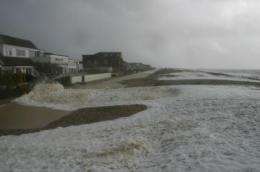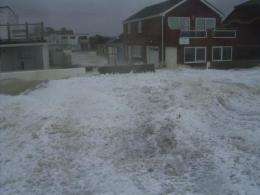This shows flooding at Hayling Island in 2005. Credit: Havant Borough Council
A unique study using over 70 years of information from local newspapers has helped to examine the incidence and location of coastal floods in the Solent region of southern England.
Coastal flood events in the Solent have been common over the last 70 years and are often associated with the highest sea levels. A significant number of events with severe impacts have been identified, with repeated damage and disruption at certain locations.
Using newly digitised sea-level data for the ports of Southampton (1935) and Portsmouth (1961) on the south coast of the UK, the University of Southampton study investigates the relationship between the 100 highest sea-level events recorded at the two cities and the incidence of coastal floods in the adjoining Solent region.
The main sources of flood data came from the daily newspapers The Southern Daily Echo, based in Southampton, and The News, based in Portsmouth, supported by a range of local publications and records.
This shows flooding at Hayling Island in 2005. Credit: Havant Borough Council
The study found a strong relationship between the highest measured sea levels and the incidence of coastal floods, and highlights the most vulnerable areas to coastal flooding, which include parts of Portsmouth, Southampton, Hayling Island, Fareham and Cowes. The most severe flood in the dataset resulted from the storm surge events of December 13, 1989 when eight consecutive extreme high waters occurred.
The study, which is published online in the Natural Hazards journal, suggests that while extreme sea-level events are becoming more common, the occurrence of flood events is not increasing.
One of the study's authors Robert Nicholls, Professor of Coastal Engineering at the University of Southampton, explains why this might be the case: "While the occurrence of extreme sea levels has increased since the 1970s, the occurrence of damaging floods has remained roughly constant over time, and fewer areas have been affected by flooding. This is mainly attributed to new and improved coastal defences at key flooding 'hotspots', such as Eastoke and Hayling, but the general decline in storm intensity since the 1980s may also be important.
"However, the significant impacts of the November 2005 flood at Hayling, despite millions of pounds of investment in defences, and the more recent flooding on the Isle of Wight in March 2008, illustrate the continuing coastal flood problems in this region. This demonstrates an ongoing need for preparedness for coastal flooding, together with improving flood defence and management in the region."
Provided by University of Southampton























